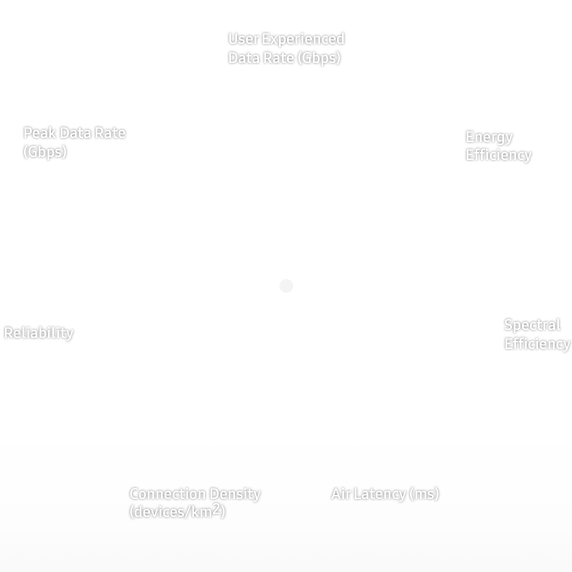
6G
The Next Hyper Connected
Experience for All

Wireless communication is an essential part of society and people’s daily lives. Today, the world is welcoming an exponential growth in advanced technologies such as artificial intelligence (AI), robotics, and automation.
In the coming years, diverse devices spanning mobile phones, AR glasses, VR headsets, and holograms as well as connected machines like vehicles, robots, home appliances and heavy machinery will become more common in our lives. These trends towards sophisticated technologies and more connected devices, in turn, are highlighting the importance of powerful networks and stable connections. This will usher in unprecedented paradigm shifts in wireless communication.
6G mobile communications promises hyper-connectivity and the ultimate experience for both consumers and industries. By combining AI applications, 6G networks will be able to collect and utilize a tremendous amount of data associated with hundreds of billions of connected machines and human needs. 6G will improve and enable access to information, resources and social services without constraints of time or physical location.



5G
6G
New advanced services in the 6G era will require a tremendous amount of real-time data processing, a hyper-fast data rate, and extremely low latency.
While 5G was designed to achieve 20Gbps peak data rate, in 6G, the industry aims to reach a peak data rate of 1,000Gbps and on average user-experienced data rates of 1Gbps. Other performance targets include air latency of less than 100 μs, end-to-end (E2E) latency of less than 1ms, and extremely low delay and jitter in the order of microseconds. With these requirements satisfied, the overall user-experienced latency can be less than 10ms, which is for example the motion-to-photon latency requirement for XR services.
Samsung also aims to support larger coverage than 5G. The maximum supported speed of mobile devices improved from 350km/h in 4G to 500km/h with 5G and may need to improve further in 6G to keep pace with the evolution of transportation systems. The explosive growth in the number of connected machines will require 6G to support about 107 devices per square kilometer. This is ten times larger than the connection density requirement of 5G.
5G services that everyone is well aware of like enhanced mobile broadband (eMBB), ultra-reliable and low latency communications (URLLC), and massive machine-type communications (mMTC), will continue to advance moving towards 6G. Samsung is focusing on new 6G services that will emerge due to advances in communications as well as other technologies such as sensing, imaging, displaying, and AI. These new services will be introduced through hyper-connectivity of everything and everyone and provide the ultimate multimedia experience.

XR is a new term that combines VR, AR, and mixed reality (MR). XR has received great attention and opened new horizons in various fields including entertainment, medicine, science, education, and manufacturing industries and will continue to evolve. For example, truly immersive AR with enhanced resolution needs higher throughput that can only be met with 6G.

Hologram is a next-generation media technology that can present gestures and facial expressions by means of a holographic display. In order to provide hologram display as a part of real-time services, extremely high data rate transmission, hundreds of times greater than current 5G system, will be essential.

With the help of advanced sensors, AI, and communication technologies, it will be possible to replicate physical entities, including people, devices, objects, systems, and even places, in a virtual world. This digital replica of a physical entity is called a digital twin. Through digital twins, users will be able to explore and monitor their reality in a virtual world, without temporal or spatial constraints. Furthermore, a digital twin could be a representation of a remotely controlled set of sensors and actuators and a user’s interaction with a digital twin can result in actions in the physical world. For example, a user could physically move within a remote site by controlling a robot in that space entirely via real-time interactions with a digital twin representation of the remote site.
Mobile communication systems have evolved over multiple generations up to 5G and each generation has taken a big step to introduce new networking technologies. The time spent for defining visions and developing technical standards for each successive generation is roughly about 10 years. The first commercial deployment of 5G happened in April 2019, which is little earlier than originally expected. This can be attributed to the accelerating growth of technologies, market needs for mobile communications and joint efforts of the ecosystem and mobile industry over the past decades. Considering these experiences, we anticipate the completion of 6G standards and its commercialization to happen around 2030. Exact timing of the first commercial deployments of 6G technologies would depend on availability of technologies and market needs.
Samsung is paving the way to 6G with diverse contributions to its standardization. Samsung has been named the Chair of ITU-R 6G Vision Group, which is in charge of establishing ITU’s 6G Vision. This includes defining key capabilities, working on technology developments, and creating timelines on 6G standardization and commercialization. To accelerate research for 6G, Samsung Research also founded its Advanced Communications Research Center in 2019. Samsung will continue its efforts and investment to successfully lead the evolution to 6G.

